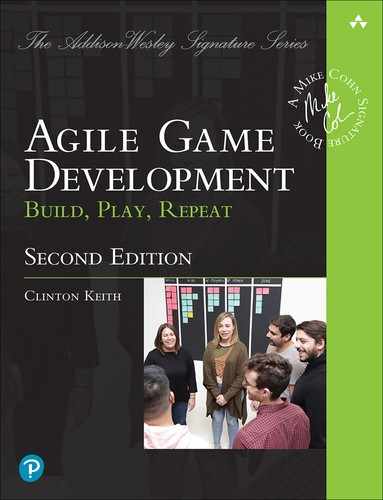Foreword
The insight that game development and Agile approaches like Scrum were a near-perfect match was no surprise to Clinton Keith. As the CTO of his studio, he was a pioneer in the pairing of Agile and game development. Though some were skeptical, Clint saw the possibilities, and as a result, he not only created the first game developed using Scrum but also helped his teams put the fun back into game development.
And why shouldn’t game development be fun as well as profitable? It’s true that the game industry is well known for aggressive deadlines and that teams are working with ambiguous requirements in a very fluid marketplace, but that is exactly the kind of environment where Agile can help the most. Because Agile is iterative and incremental and forces a team to put the game into a playable state at least every one to four weeks, the team members can see new features and scenarios develop right before their eyes.
In Agile Game Development: Build, Play, Repeat, Clint shares his experience and insights with us. He tells us everything we need to know to successfully use Agile in the challenging field of game development. In this new, expanded second edition there is additional coverage on live and mobile games. There’s also new material on scaling Agile to large projects and the extra complexity of “AAA” console games.
The subtitle of this book—Build, Play, Repeat—is apt. It refers to both how a video game is developed and how a good game team should take ownership of its development process. That, too, must be built, played with, and the cycle repeated endlessly as a team seeks continually to improve. What better way to seek continual improvement than to hear stories and get advice from the pioneer who first merged Agile and game development?
Throughout the book, Clint offers invaluable guidance on getting all the specialists who are necessary on a game project to work together in an Agile manner. He even delves into how to use Scrum when working with a publisher. In providing all of this guidance, Clint doesn’t shy away from the challenges, including the hard ones of creating an Agile-friendly culture. Instead, he generously shares his advice so that we can perhaps avoid common and dangerous pitfalls.
There is little doubt in my mind that the book you are holding can have a profound effect on any game project and studio. After being introduced to and accustomed to Agile, team members will not want to work any other way. They will have learned what Clint knew long ago—that Scrum is the best way to handle the complexity and uncertainty of game development.
—Mike Cohn
Cofounder, Scrum Alliance and Agile Alliance
